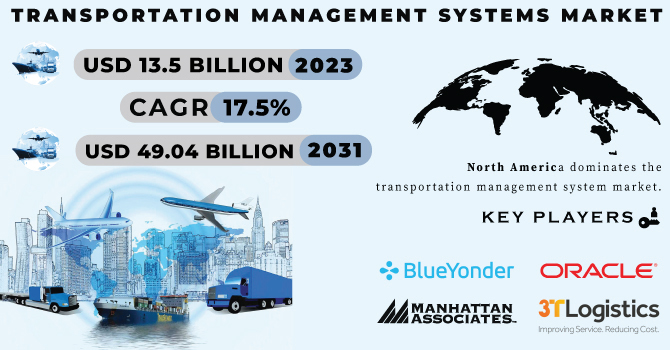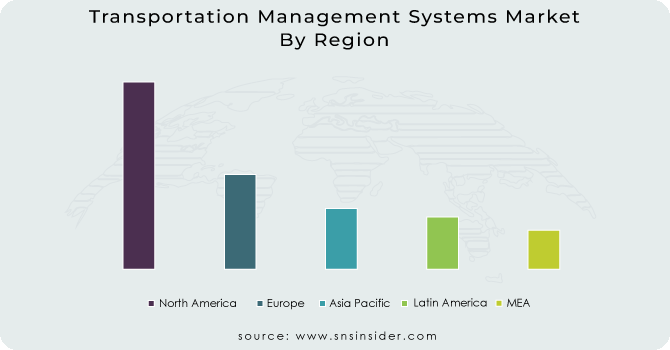Transportation Management Systems Market Overview:
The Transportation Management Systems (TMS) Market Size was valued at USD 13.5 billion in 2023 and is expected to reach USD 49.04 billion by 2031 and grow at a CAGR of 17.5% over the forecast period 2024-2031.

To get more information on Transportation Management Systems Market - Request Sample Report
A transportation management system (TMS) is a software platform that automates the transportation process, which is a component of the supply chain. It is responsible for monitoring, arranging, controlling, and handling all aspects of product transportation from the time an order is placed until it is delivered. The need for transportation management systems can never be overstated, given the increasing complexities of logistics and transportation as a business grows. Technically, TMS allows a superior transactional and communication system, allowing users to make better judgments, plan and strategize for ideal transportation solutions, and exploit huge real-time data.
Transportation management solutions assist businesses in lowering overall costs, increasing shipment efficiency, and offering real-time supply chain information. Users can leverage cloud-based solutions to improve time-to-value by managing logistical processes more efficiently, connecting and collaborating with trading partners, and reusing and sharing supply chain data. Transportation management systems are also linked to freight savings as a result of process optimization, effective routing, and the use of low-cost modes of transportation.
MARKET DYNAMICS
KEY DRIVERS
-
The emergence of digitization, from connected warehouses to new mileage delivery systems, boosts the visibility of TMS.
-
Transportation and logistics industry technological advancements
RESTRAINTS
-
Concerns about security and privacy are increasing among businesses, which is limiting the TMS market's growth.
-
Companies with low financial resources are unable to invest in automation systems.
OPPORTUNITIES
-
Technology advancements, such as IoT and cloud-based services, present prospects for the market's overall growth.
-
The transportation and logistics business will be transformed by autonomous and networked cars.
CHALLENGES
-
The digitalization of transportation operations necessitates significant capital expenditures, all of which are costly.
-
The slow adoption of many IoT platforms and a large number of APIs are due to the integration complexity.
IMPACT OF COVID-19
Since the coronavirus outbreak, the worldwide transportation management systems market has suffered. As a result of the pandemic, a number of countries have imposed lockdowns and closed businesses save for critical services. These lockdowns have resulted in a significant decline in travel and transportation in recent years. The travel and tourism industry relies heavily on transportation. Companies in the sector must keep their fleets in good operating order in order to provide better services to their customers. With the rise of the general travel & tourist business, overall competition is increasing dramatically, and organizations are investing in expanding their supply chains and logistics channels by deploying complete transport management systems in order to compete effectively in the market. As several governments prepare to lift the lockdowns, demand for this software is expected to rebound in the coming months. The majority of enterprises have been given the authorization to continue operations in accordance with safety rules by the governments of several countries.
MARKET ESTIMATION
Market, By Component
Based on the Component segment, the global market has been divided into solution, and services. The solution segment dominated the global transportation management system market by component, since solutions aid in the optimization of the complete supply chain process, leading to improved profit margins and growth. However, because of the reduced time and costs associated with system optimization, the services segment is predicted to increase the most.
Market, By Deployment
Based on the development segment, the global market has been divided into on-premise, and cloud. In 2023, the on-premise sector had the biggest market share, with over 57 %. Several firms still prefer on-premise solutions because they provide easier access to the server, more customization options, and adequate data security. This has aided the segment's expansion.
Market, By Industry
Based on the industry segment, the global market has been divided into Retail, Energy & Utilities, Manufacturing, Healthcare & Pharmaceutical, Government Sector, and Others. In 2023, the manufacturing sector held the greatest market share of more than 35%. The growing number of industrial units in emerging economies has boosted demand for raw materials and, as a result, transportation costs.
Market, By Transportation Mode
Based on the transportation segment, the global market has been divided into roadways, airways, railways, and maritime. In 2023, the segment of the roadways had the biggest market share, accounting for more than 41%. Because it may load and unload at any location, road transportation is considered cost-effective and adaptable. The waterways segment is expected to increase at a significant rate. The airways segment is also expected to increase significantly.
KEY MARKET SEGMENTATION
By Component
-
Solution
-
Services
By Deployment
-
On-premise
-
Cloud
By Industry
-
Retail
-
Energy & Utilities
-
Manufacturing
-
Healthcare & Pharmaceutical
-
Government Sector
-
Others
By Transportation Mode
-
Roadways
-
Airways
-
Railways
-
Maritime
REGIONAL ANALYSIS
Because of the high number of companies and industry columns, North America dominates the transportation management system market. The TMS industry is one of the primary sectors in the North American landscape, delivering the largest income worldwide. The United States and Canada are collaborating to gain a larger portion of the market for transportation management systems. Furthermore, the transportation management system market in Canada is expected to grow at the quickest rate. Due to increased worldwide trade, Asia-Pacific is predicted to grow rapidly, particularly in emerging economies such as China and India. Furthermore, smartphone penetration is expanding in the Asia-Pacific area, owing to non-renewable revenue. Various elements all have a role in the growth of e-commerce in these sectors.

To Get Customized Report as per your Business Requirement - Request For Customized Report
REGIONAL COVERAGE:
-
North America
-
USA
-
Canada
-
Mexico
-
-
Europe
-
Germany
-
The UK
-
France
-
Italy
-
Spain
-
The Netherlands
-
Rest of Europe
-
-
Asia-Pacific
-
Japan
-
South Korea
-
China
-
India
-
Australia
-
Rest of Asia-Pacific
-
-
The Middle East & Africa
-
Israel
-
UAE
-
South Africa
-
Rest of Middle East & Africa
-
-
Latin America
-
Brazil
-
Argentina
-
Rest of Latin America
-
KEY PLAYERS
The Major Palyers are Oracle (US), 3T Logistics & Technology Group (UK), Blue Yonder (US), Manhattan Associates (US), Trimble (US), Blujay Solutions (US), SAP (US), MercuryGate International (US), Transplace (US), Descartes Systems Group (Canada), Logistically (US), E2open (US), Alpega Group (Belgium), 3Gtms (US), Globaltranz (US), C.H. Robinson (US), InMotion Global (US), vTradEx (China), MP Objects (US), One Network Enterprises (US), Elemica (US), Tailwind Transportation Software (Canada), IntelliTrans (US), Allotrac (Australia), Revenova (US), Ratelinx (US), Tracx Systems (Canada), WiseTech Global (Australia), Princeton TMX (US), CTSI Global (US), Fretron (India), Generix Group (France), Unifaun (Sweden), Efreightsolutions (US), Ultraship TMS (US), Supplystack (Belgium), and Other Players
3T Logistics & Technology Group (UK)-Company Financial Analysis

| Report Attributes | Details |
|---|---|
| Market Size in 2023 | US$ 15.99 Billion |
| Market Size by 2031 | US$ 56.94 Billion |
| CAGR | CAGR 16.7% From 2024 to 2031 |
| Base Year | 2023 |
| Forecast Period | 2024-2031 |
| Historical Data | 2020-2022 |
| Report Scope & Coverage | Market Size, Segments Analysis, Competitive Landscape, Regional Analysis, DROC & SWOT Analysis, Forecast Outlook |
| Key Segments | • by Component (Solution, Services) • by Deployment (On-premise, Cloud) • by Industry (Retail, Energy & Utilities, Manufacturing, Healthcare & Pharmaceutical, Government Sector, Others) • by Transportation Mode (Roadways, Airways, Railways, Maritime |
| Regional Analysis/Coverage | North America (USA, Canada, Mexico), Europe (Germany, UK, France, Italy, Spain, Netherlands, Rest of Europe), Asia-Pacific (Japan, South Korea, China, India, Australia, Rest of Asia-Pacific), The Middle East & Africa (Israel, +D11UAE, South Africa, Rest of Middle East & Africa), Latin America (Brazil, Argentina, Rest of Latin America) |
| Company Profiles | Oracle (US), 3T Logistics & Technology Group (UK), Blue Yonder (US), Manhattan Associates (US), Trimble (US), Blujay Solutions (US), SAP (US), MercuryGate International (US), Transplace (US), Descartes Systems Group (Canada), Logistically (US), E2open (US), Alpega Group (Belgium), 3Gtms (US), Globaltranz (US), C.H. Robinson (US), InMotion Global (US), vTradEx (China), MP Objects (US), One Network Enterprises (US), Elemica (US), Tailwind Transportation Software (Canada), IntelliTrans (US), Allotrac (Australia), Revenova (US), Ratelinx (US), Tracx Systems (Canada), WiseTech Global (Australia), Princeton TMX (US), CTSI Global (US), Fretron (India), Generix Group (France), Unifaun (Sweden), Efreightsolutions (US), Ultraship TMS (US), Supplystack (Belgium), and Infor (US) are some of the major vendors in the Transportation Management Systems Market. |
| Key Drivers | •Transportation and logistics industry technological advancements. |
| Market Opportunities | •The transportation and logistics business will be transformed by autonomous and networked cars. |

